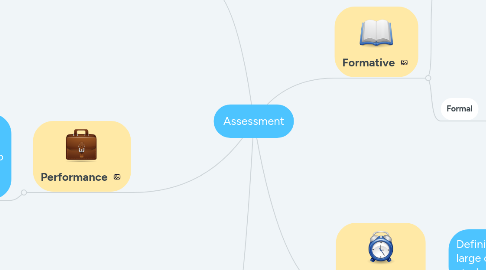
1. Benchmark
1.1. Definition: Short tests given periodically throughout the year to measure students progress and to give teacher immediate feedback to adjust instruction.
1.1.1. Types of Benchmark Assessments:
1.1.2. Multiple choice tests
1.1.3. Resemble state standardized tests
1.1.3.1. Benefits to Benchmark Assessment: Teachers are able to use this immediate feedback to adjust instruction and create individualized instruction for what certain students are struggling with. Prepares students for what State standardized test will look and be like.
1.1.4. Used to show how well students are prepared for state standardized tests.
2. Diagnostic
2.1. Definition: Prior to instruction (pre-assessment) to see students prior skills and knowledge, so that a teacher is able to adjust instruction before lesson to meet the needs of each student.
2.1.1. Types of Diagnostic assessments:
2.1.2. Unit pre-test
2.1.3. KWL Chart
2.1.3.1. Benefits of Diagnostic assessment: Teachers are able to individualize instruction based on students prior knowledge. Also helps teachers have a baseline for where students are at.
2.1.4. Pre quiz
2.1.5. Concept test
2.1.6. MAP testing
3. Performance
3.1. Definition: Requires students to do a task instead of just answering questions on a test. It is also known as authentic assessment.
3.1.1. Types of Performance Assessments:
3.1.2. Real life scenarios and tasks given to students: Creating a balanced Budget, creating a new Cereal brand, Planning a vacation etc.
3.1.2.1. Benefits of Performance Assessments: Teachers are able to assess students based on their content knowledge and their ability to apply that knowledge in higher order thinking scenarios. It also develops work habits, such as, time management, responsibility, working well with others, etc.
3.1.3. Project Based learning
3.1.4. Group projects
3.1.5. Journals
3.1.6. Portfolios
4. Formative
4.1. Informal
4.1.1. Definition: Used to adjust instruction to help achievement. Immediate evidence of student learning, and provides feedback.
4.1.1.1. Types of Informal Formative Assessments:
4.1.1.2. Observing Student Work
4.1.1.3. Fist to Five
4.1.1.4. Clear as Mud
4.1.1.4.1. Benefits of informal formative assessment : Allows the teacher to see what students are struggling with very quickly and adjust instruction accordingly.
4.1.1.5. Thumbs up/ Thumbs Down
4.1.1.6. Questioning
4.2. Formal
4.2.1. Definition: Used to adjust instruction to help achievement, gives evidence of student learning and provides feedback.
4.2.1.1. Types of Formal Formative Assessments:
4.2.1.2. Structured Assignments
4.2.1.3. Pretests
4.2.1.4. Homework
4.2.1.5. In class assignment
4.2.1.5.1. Benefits of formal formative assessment: Allows the teacher to see what students are struggling with and what needs to be retaught..
4.2.1.6. Quizzes/ Unit Tests
4.2.1.7. Classroom response system
5. Summative
5.1. Definition: Assessment used at the end of a large chunk of learning, to see what students have learned.
5.1.1. Types of Summative Assessments:
5.1.2. Standardized tests
5.1.3. Final exams
5.1.3.1. Benefits of summative assessment: You are able to see which students truly did not understand a topic and need a reteach. Also gives students motivation to pass these types of tests and gives students good test taking skills.
5.1.4. Cumulative projects
5.1.5. Research projects

